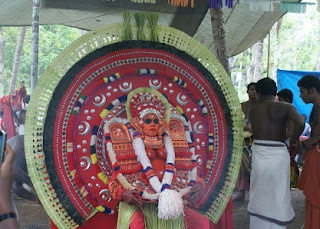Friday, 18 October 2013
Wednesday, 3 April 2013
തീച്ചാമുണ്ഡീ
This variety of Theyyam, the ritual dance performance, is presented
during the night.
An offering to Lord Vishnu’s incarnation- Narasimhavathra – part lion
part man- this ritual dance is an awe inspiring one and it is believed
that the performer of this gets possessed by the spirit of the god.
Thee Chamundi Theyyam performance is based on the mythological story
of Hiranyakashipu, Narasimha and his disciple Prahlada.
Hiranyakashipu (the king of Asuras), is a
demon in Hindu myths. His younger brother,
Hiranyaksha was killed by Vishnu, during his
Varaha incarnation. Enraged at this, he
decided to kill Vishnu by acquiring magical
powers from Brahma by performing a penance
for him. At last he succeeded in securing a
boon from Brahma that he would not die on
earth or in space, or in fire or water, not
during the day or night, not inside or
outside and not by the hand of a human, god,
animal or any other animate or inanimate
species.
Hiranyakashipu is father of Prahlada (an
ardent devotee of Lord Vishnu). The asura
king, whose wish is to kill Lord Vishnu tries
a number of times to burn Prahlada alive.
Finally the NarashimhFriday, 8 March 2013
Classification of Sub Cults
It can be said that all the prominent characteristics of primitive, tribal, religious worship had widened the stream of Theyyam cult, where "even the followers of Islam are associated with the cult in its functional aspect"[2] and made it a deep-rooted folk religion of millions. For instance, the cult of Bhagawathi, the Mother Goddesses had and still has an important place in Theyyam. Besides this, the practices like spirit-worship, ancestor-worship, hero-worship, masathi-worship, tree-worship, animal worship, serpent-worship, the worship of the Goddesses of disease and the worship of Graamadevataa (Village-Deity) are included in the main stream of the Theyyam cult. Along with these Gods and Goddesses there exist innumerable folk Gods and Goddesses. Most of these Goddesses are known as Bhagavathy (the Mother-Goddess that is the Divine and United form of the three principal Goddesses namely, Brahmani (Saraswati), Vaishnavi (Lakshmi), and Shivani (Durga)).
Different branches of mainstream Hindu religion such as Shaktism, Vaishnavism and Shaivism now dominate the cult of Theyyam. However, the forms of propitiation and other rituals are continuations of a very ancient tradition. In several cult-centres, blood offering is seen, despite being forbidden in sattvic Hinduism, Jainism and Buddhism. In such centres, separate places outside the precincts of the shrine are selected for blood offering and for the preparation of the traditional Kalam known as Vatakkanvathil. The Theyyam deities propitiated through cock-sacrifice will not enter such shrines. This religious cockfight over blood sacrifice, which does also include the cockfight as a blood sacrifice, is a prime example of "cultural synthesis of 'little' and 'great' cultures".[3]
On account of the supposedly late revival of the Vaishnavism movement in Kerala, it does not have a deep impact on the Theyyam cult. Only a few deities are available under this category. Two major Theyyam deities of Vaishnavism are Vishnumoorthi and Daivathar. Vaishnavism was very popular in the Tuluva region in the 13th century when it came under the rule of Vishnuvardhana of the Hoysala dynasty. He was a great champion of Vaishnavism. Most probably he was initially deified as Vishnumoorthi and incorporated into the Bhoota cult of the Tuluvas and then further incorporated as a prominent folk deity into the Theyyam cult as well. To some, the legend of Vishnumoorthi is symbolizes the God's migration from Tulu Nadu to Kolathunadu.
All other categories of Theyyam deities can be classified under Shaivism or Shaktism. Even spirits, ancestors, heroes, and animals are deified and included in those categories. Briefly, Theyyam provides a good example for the religious evolution of, and the subsequent different stages in modern Hinduism, with the overall understanding that within Hindu sycretisms lay propitiation as ancient practices and rituals of ancient worship intended for the blessings of the supernatural not unlike, "in Indus Valley and other ancient civilizations, mother goddess had been invoked for fertility and prosperity".[4]
Wednesday, 6 March 2013
History of THEYYAM
History
According to the legendary Keralolpathi, Parasurama sanctioned festivals like Kaliyattam, Puravela and Daivattam or Theyyattam to the people of the North Malabar region. He also assigned the responsibility of performing the Theyyam dance to the indigenous tribal communities like Malayar, Panan, Vannan and Velan. "There can be no doubt", say Bridget and Raymond Alchin, "that a very large part of this modern folk religion is extremely ancient and contains traits which originated during the earliest periods of Neolithic, Chalcolithic settlement and expression".(Wikipedia)
Subscribe to:
Comments (Atom)









